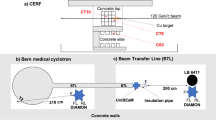Abstract
Neutrons from collisions of cosmic rays with the nuclei of atoms in the atmosphere are an irremovable external radiation that causes single-event upsets in microelectronic devices. Predicting soft error rates requires knowledge of the flux and energy distribution of the cosmic-ray-induced neutrons. This article reviews cosmic-ray neutrons in the atmosphere and on the ground, the factors that determine their intensity, and recent calculations and state-of-the-art measurements of neutron spectra covering 12 decades of energy, from the thermal energy range up to 10 GeV.
Similar content being viewed by others
References
IBM J. Res. Develop. 40 (1) (1996).
G. Reitz, Radiat. Prot. Dosim. 48 (1993) p. 5.
J.M. Clem, D.P. Clements, J. Esposito, P. Evenson, D. Huber, J. ’Heureux, P. Meyer, and C. Constantin, Astrophys. J. 464 (1996) p. 507.
T.K. Gaisser, Cosmic Rays and Particle Physics (Cambridge University Press, Cambridge, 1990).
Bartol Research Institute Neutron Monitor Web site, http://www.bartol.udel.edu/—neutronm, then click on Solar Modulation (accessed November 2002).
University of New Hampshire Neutron Monitor Web site, http://ulysses.sr.unh.edu/NeutronMonitor/Misc/neutron2.html, then click on *1950–2002 under Plots (accessed November 2002).
J.W. Wilson, J.E. Nealy, F.A. Cucinotta, J.L. Shinn, F. Hajnal, M. Reginatto, and P. Gold-hagen, Radiation Safety Aspects of Commercial High-Speed Flight Transportation, NASA Technical Paper 3524 (National Technical Information Service, Springfield, VA, 1995).
J.M. Clem, J.W. Bieber, P. Evenson, D. Hall, J.E. Humble, and M. Duldig, J. Geophys. Res. 102 (1997) p. 26919.
P.H. Stoker, in Proc. 24th Int. Conf. on Cosmic Rays, Vol. 4 (Copernicus Gesellschaft, 1995) p. 1082.
J. Clem and L. Dorman, Space Sci. Rev. 93 (2000) p. 335.
J.F. Ziegler, “Terrestrial Cosmic Ray Intensities,” IBM J. Res. Dev. 42 (1) (1998) p. 117, available at www.research.ibm.com/journal/rd/421/ziegler.html (accessed November 2002).
P. Goldhagen, Health Phys. 79 (2000) p. 526.
P.K.F Grieder, Cosmic Rays at Earth: Researchers Reference Manual and Data Book (Else-vier, Amsterdam, 2001).
T. Foelsche, R.B. Mendell, J.W. Wilson, and R.R. Adams, Measured and Calculated Neutron Spectra and Dose Equivalent Rates at High Altitudes: Relevance to SST Operations and Space Research, NASA Technical Note D-7715 (National Technical Information Service, Springfield, VA, 1974).
J.W. Wilson, L.W. Townsend, W. Schimmerling, G.S. Khandelwal, F. Khan, J.E. Nealy, F.A. Cucinotta, L.C. Simonsen, J.L. Shinn, and J.W. Norbury, in Transport Methods and Interactions for Space Radiations, NASA Reference Publication 1257 (National Technical Information Service, Springfield, VA, 1991) p. 519.
K. O’Brien, LUIN, a Code for the Calculation of Cosmic Ray Propagation in the Atmosphere (Update of HASL-275), U.S. Department of Energy Technical Report EML-338 (National Technical Information Service, Springfield, VA, 1978).
K. O’Brien and F. Friedberg, Environ. Int. 20 (1994) p. 645.
E. Normand and T.J. Baker, IEEE Trans. Nucl. Sci. 40 (1993) p. 1484.
E. Normand, IEEE Trans. Nucl. Sci. 43 (1996) p. 461.
International Commission on Radiological Protection, Annals of the ICRP 21, IRP Publication 60 (Pergamon Press, Elmsford, NY, 1991).
A. Fasso, A. Ferrari, A. Ranft, and P.R. Sala, in Proc. Third Workshop on Simulating Accelerator Radiation Environments (SARE-3), edited by H. Hirayama (KEK, Tsukuba, Japan, 1997) p. 32.
S. Roesler, W. Heinrich, and H. Schraube, Radiat. Prot. Dosim. 98 (2002) p. 37.
A. Ferrari, M. Pelliccioni, and T. Rancati, Radiat. Prot. Dosim. 93 (2001) p. 101.
P. Goldhagen, M. Reginatto, T. Kniss, J.W. Wilson, R.C. Singleterry, I.W. Jones, and W. Van Steveninck, Nucl. Instrum. Methods A 476 (2002) p. 42.
P. Goldhagen, J.M. Clem, and J.W. Wilson, Adv. Space Res. in press.
R.L. Bramblett, R.I. Ewing, and T.W. Bonner, Nucl. Instrum. Methods 9 (1960) p. 1.
D.J. Thomas and A.V. Alevra, Nucl. Instrum. Methods A 476 (2002) p. 12.
L.S. Waters, ed., MCNPX User’s Manual, Version 2.3.0, Report LA-UR 02–2607 (Los Alamos National Laboratory, Los Alamos, NM, April 2002).
M. Reginatto and P. Goldhagen, MAXED, A Computer Code for the Deconvolution of Multi-sphere Neutron Spectrometer Data Using the Maximum Entropy Method, U.S. Department of Energy Environmental Measurements Laboratory Technical Report EML-595 (1998), available on-line at www.eml.doe.gov/publications/reports (accessed November 2002).
M. Reginatto and P. Goldhagen, Health Phys. 77 (1999) p. 579.
S. Roesler (private communication).
J.M. Clem, G. De Angelis, P. Goldhagen, and J.W. Wilson, Adv. Space Res. in press.
Rights and permissions
About this article
Cite this article
Goldhagen, P. Cosmic-Ray Neutrons on the Ground and in the Atmosphere. MRS Bulletin 28, 131–135 (2003). https://doi.org/10.1557/mrs2003.41
Published:
Issue Date:
DOI: https://doi.org/10.1557/mrs2003.41




